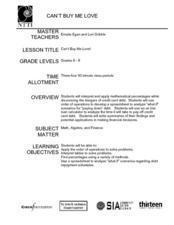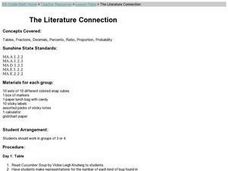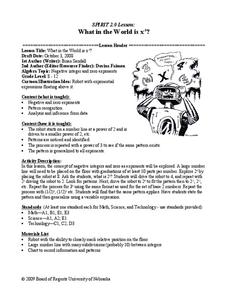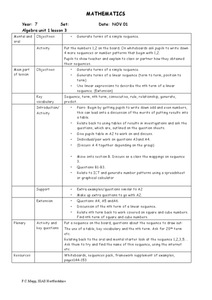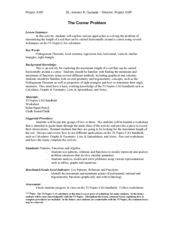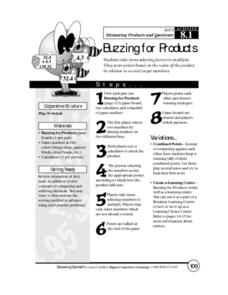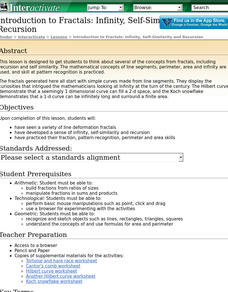Curated OER
Finding the Salt Front
Learners discuss definitions of estuary, salinity, and the salt front. They listen as the teacher explains the Hudson River Miles and ways the upriver and downriver sections relate to the north and south. Students graph the salt front...
Curated OER
Pepe Cleaners
Seventh graders gather data to determine the relationships between the base and height of rectangles with fixed perimeters and express the relationships using words and symbols. Students build rectangles with pipe cleaners. They create...
Curated OER
Around and Across
Tenth graders investigate the circumference and diameter of a circle. In this geometry lesson, 10th graders relate circumference to diameter. They create a scatter plot to estimate the value of pi.
Curated OER
Understanding Cloud Formation
Students read and relate the poem, "Clouds" by Aileen Fisher to a demonstration on cloud formation. They create clouds in jars using ice water and matches then discuss the ways clouds can be used to predict weather.
Curated OER
Cannot Buy Me Love
Young scholars investigate the concepts that are related to finance and how it is used in the world. They take part in activities that are focused around the use of a spreadsheet while using a T-chart to simulate a ledger of credits and...
Curated OER
The Literature Connection
Second graders read Cucumber Soup by Vickie Leigh. They make representations for the number of each kind of bug found in the book. This lesson plan is a terrific way to show students how fractions, decimals and percents are related.
Curated OER
How Many Cards Do We Need to Display the Dates of the Month?
Students complete activities to study the concept of place value notation. In this place value lesson, students use cards for the days of the month that only number from 1 to 9. Students find a subtraction pattern to determine the amount...
Curated OER
Social Studies: Adinkra Printing
First graders demonstrate a sense of artistic composition by creating shapes and symbols in the pattern of African Adinkra printing. They use glue to create a raised design and then print it on colored paper. Students use symbols from...
Curated OER
Food Journal Exercise
Students are required not to change their usual eating pattern while recording everything they eat and drink for 1 day. They evaluate the nutrient composition of their diet, as well as their dietary intake and behavior within the...
Curated OER
Getting to the Core of Climate Change
Students investigate climate changes by graphing and analyzing ice core data from Greenland and Antarctica. They create, explain and report the pattern of data on a graph of ice core data. In addition they find relationships between the...
Curated OER
Solar System Search
Students research topics related to space and the planets using the Internet. They explore various websites, construct scale models of the solar system, and create a travel brochure using HyperStudio computer software.
Curated OER
Weather, Data, Graphs and Maps
Students collect data on the weather, graph and analyze it. In this algebra lesson plan, students interpret maps and are able to better plan their days based on the weather reading. They make predictions based on the type of clouds they...
Curated OER
Let's Play Scrabble!
What do Alfred Mosher Butts, James Brunot, and Jack Straus have in common? They were all instrumental in the development of Scrabble. Class members will discover these facts and many more as they conduct a WebQuest to gather, organize,...
Curated OER
Tangrams
Students construct the tangram pieces from a square paper by following directions to fold and cut. They make observations on the pieces formed and compare how they are related to each other. Students explore patterns and shapes with...
Curated OER
Negative Exponents
Students solve negative exponential functions. In this algebra lesson, students define the properties for rewriting functions with negative and zero exponents. They use a robot to create a visual of what is happening to the negative...
Curated OER
Amazing Consistent Ratios
Learners derive the six trigonometric identities. For this trigonometry lesson, students find the ratios of sine, cosine and tangent using the right triangle. They use properties of the Pythagorean Theorem to find the trig identities.
Curated OER
Simple Sequence
Students identify the nth term in a sequence. For this algebra lesson, students generate sequences given the formula for each sequence. They find the formula given the sequence.
Curated OER
The Corner Problem
Students explore the concept of the corner problem. In this corner problem lesson, students use the TI-NSpire to determine the maximum length a rod can be and still pass horizontally around a corner. Students use similar triangles to...
Curated OER
Polynomial Functions
Students explore polynomial functions. For this Algebra II lesson, students explore graphs of polynomial functions as classify the functions as linear, quadratic, cubic, or quartic. Students determine the regression equation...
Curated OER
Who Wants Pizza?
Students practice fraction skills online at the "Want Some Pizza" website. They complete activities via the internet and on square grid paper. They pull down tabs to check their answers.
Curated OER
Buzzing for Products
Students practice multiplication playing a game. In this multiplication lesson plan, students pick numbers and multiply them together. Students are awarded points based on which "hive" their answer falls in. The student with the...
Curated OER
Tangram Puzzles
Young scholars explore the origin of tangram. In this algebra lesson, students form different shapes and figures using tangram. They solve for the area of different shapes without using any geometric formulas, but the idea of tangram...
Curated OER
Falling Into Geometry Through Paper Art
Students explore geometric shapes. In this kindergarten geometry lesson plan, students create a fall quilt consisting of three different paper geometric quilt squares that when assembled form a scarecrow, a pumpkin, and a...
Curated OER
Introduction to Fractals: Infinity, Self-Similarity and Recursion.
This instructional activity introduces students to the ideas involved in understanding fractals. They develop a sense of infinity, self-similarity and recursion and




